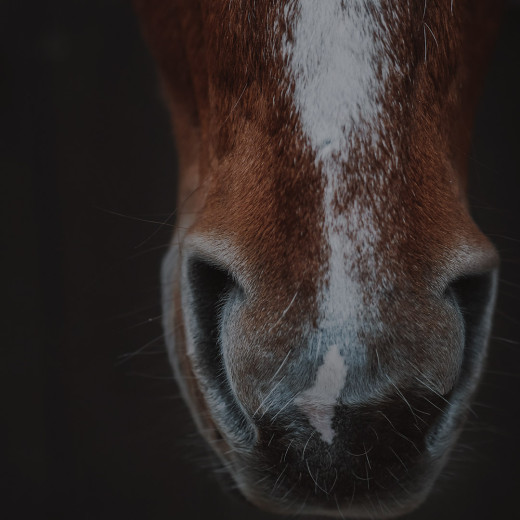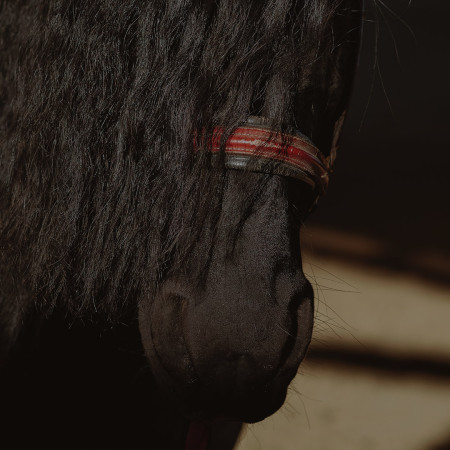
Inflammatory Airway Disease (IAD)
Description
A frequent problem, discrete clinical signs
IAD affects many horses of all ages. This disease is frequent in race horses (trotters and gallopers) as well as sports and leisure horses. However, it is not always easy to identify. Indeed, the clinical signs can be very discreet especially at the onset of disease: poor performance in racing or sport horses, abnormal breathlessness or prolonged recovery. When the condition is more severe, an intermittent cough can occur. But unlike RAO, IAD does not cause marked clinical signs at rest: no respiratory distress nor deep cough.
Causes of IAD
As with the RAO, dust is the main cause of IAD. Prehistoric horses used to be wild and live in the open air eating grass 18h a day. Domesticated horses we know today have a completely different lifestyle: most live inside stalls with suboptimal ventilation, on straw bedding, and are fed dry hay. The respiratory system of the horse has yet not adapted to this new environment and the dust that goes with it. Dust is essentially made of a mixture of plant and bacteria fragments (some bacterial fragments named endotoxins are extremely irritant), mould and mould fragments (Aspergillus, Penicillium, Mucor, Alternaria, etc.).
Dust particles are of variable size. Respirable particles (less than 5 micrometers in diameter) are able to be inhaled down to the deepest parts of the lungs, in the bronchioles and alveoli. In an ordinary stable, each millilitre of air contains about 3000 respirable particles. With each inspiration, a horse thus inspires…12 million respirable particles!
These little particles trigger a protective response of the lungs. In some horses, this reaction is exacerbated and induces an increased production of mucus, a thickening of the mucosa (the thin cell layer that covers the inside of the airways and the lungs) and a broncho constriction (reflex contraction of the smooth muscles around the airways that reduces the air passage diameter).
How to Diagnose IAD
IAD should be suspected in case of chronic intermittent cough without fever or changes in general demenaour (the horse eats well, is not depressed). IAD may also be suspected in case of abnormal breathlessness or prolonged recovery, and in case of poor performance without further explanation (lameness for example). The veterinarian will first try to exclude another cause to the symptoms observed by conducting a thorough clinical examination and possibly blood tests. To confirm the diagnosis, the veterinarian will then perform a sample deep in the lungs: the bronchoalveolar lavage. For this, he introduces a long and smooth tube into the horse’s trachea to the lungs and then instils sterile physiological serum and sucks it back up for laboratory tests. The laboratory will evaluate the different types of cells present in the sample, which will make it possible to establish the diagnosis.
How to treat IAD
The medical treatment of ADI, as for RAO (emphysema), aims at decreasing inflammation and bronchoconstriction. We thus use steroidal anti-inflammatory drugs (corticosteroids) and bronchodilators. Mucus-thinning drugs and expectorants can also be added to the treatment. These products can be administered by injectable or oral routes or by inhalation. The latter makes it possible to deliver the product directly to the airways. It requires smaller doses of drugs and reduces the body exposure to the drug (no or fewer side-effects). A horse-adapted nebuliser is needed. Some other products mostly based on essential oils can be used as a complement to the classical treatment, to potentiate it and/or to reduce the risk of relapse.
Eliminate the dust!
IAD, as RAO, is closely linked to the environment. Thus, its management must imperatively include measures to reduce dust in the breathing environment of the horse. Otherwise, symptoms are bound to reappear as soon as the medical treatment is finished. To reduce dust in the environment, simple measures are recommended: replace straw bedding by dust-free wood shavings, eliminate dry hay and replace it by sterilised hay or good quality haylage, increase ventilation in the stall and the stable in general, take the stocks of hay and straw out of the stable and put them in a clean and dry place, protected from the rain, take the horse out in a field or a paddock regularly, etc.
A new name for IAD
Recently, scientific research has revealed that IAD and RAO have very similar mechanisms and that the two diseases differ basically in their severity. It also appears that these two diseases have much in common with human asthma. It has thus been suggested that the terms moderate equine asthma (for IAD) and sevre equine astma (RAO) might be the most adapted.
Dr. med. vet. Julie Dauvillier




